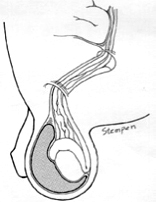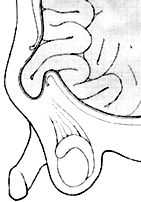Contact Information
Hydrocele

A hydrocele is a painless collection of fluid surrounding the testicle which makes the scrotum appear large (see figure 1). It is common in newborn males. Most hydroceles in newborns are harmless and will resolve on their own by 12 months of age. The causes of hydroceles that develop in children are different from those in adults. The testicles initially develop in the abdomen (belly). In most boys, they move down into the scrotum before birth. As they do this, some of the lining of the abdomen (called the peritoneum) comes down as a sack containing the testicle. In most boys, the sack's connection to the abdomen is closed at birth, but in some boys it remains open. When it is open fluid produced in the abdomen can then freely move into the scrotum and back (which accounts for changes in size often observed).
Hernia

In males, a hernia in the groin occurs when a loop of bowel slips into the scrotum through an opening between the abdomen and the scrotum (see figure 2). There are usually no symptoms, but the mass feels soft and separate from the testicle. Many times, the mass will “pop out” and with gentle pressure, it can be pushed back in. Sometimes, the hernia will get stuck out, and will not be able to be pushed back in – in this case, there may be a larger bulge than before and it may be more firm, more red or tender to touch. Sometimes, the intestine gets trapped in the connection and the intestine can kink. When this occurs, the child will be extremely fussy or uncomfortable (severe, persistent crying), may vomit, complain of abdominal pain, and have diarrhea or constipation. This is a situation which deserves immediate medical attention from your pediatrician or pediatric urologist. Fortunately, this situation is not that common. In females, swelling usually occurs in the labia (vaginal lips). In general, a hernia is usually not serious if it can easily be pushed back in. However, it is something that, if ignored, can become a problem in the future.
Treatment
Hydroceles that do not resolve on their own, and all hernias, need to be repaired. This is done as a same-day surgical procedure. A small incision is made in the groin so that the opening can be found. Then the fluid is drained and/or the intestine is returned to abdomen. The opening is then tied off to close the connection between the abdomen and scrotum.
An open connection may be present on the opposite side in up to 10% of children without showing any signs of it being there. Some surgeons will test to see if the open connection is present on the opposite side at the time of repairing the obvious side and, if present, repair it at the same time.